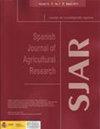Pistachio nut diffusion in Spain: Growth models
IF 0.8
4区 农林科学
Q3 AGRICULTURE, MULTIDISCIPLINARY
引用次数: 0
Abstract
Aim of study: To analyse the diffusion of the crop by producing forecast models, that intend to help farmers in their decision-making. Area of study: Spain. The area dedicated to pistachio cultivation in Spain has multiplied by 36 in the period 2010 to 2020, reaching 44,244 ha. Material and methods: This study brings together data on the evolution of pistachio cultivation based on the following parameters: cultivated area, yield, and price. Methods are based on internal, external influence models and on an influence-price-crop yield pattern. Main results: The results indicate that given a constant crop yield, raising pistachio prices, will bring a production increase that generate the saturation level of the system. Similarly, with a constant pistachio price and an increment of the crop yield, the saturation level of the system increases. Regarding the pattern of influence, it is shown that in a context of suitable market prices for pistachio and an optimal synergy of the production factors that favour the crop yield not only increases the level of saturation of the system but also the duration of the diffusion process. Research highlights: The diffusion curve is sigmoidal with a well-defined inflection point and three well-defined phases. The adoption of pistachio in Spain responds to a model of internal influence (logistic) and never to models of external influence. According to the results, the process has a zero-innovation effect, while the dynamics of the process is completely determined by an imitation effect.开心果在西班牙的扩散:增长模型
研究目的:通过建立预测模型来分析作物的扩散情况,以帮助农民做出决策。研究领域:西班牙。2010年至2020年,西班牙开心果种植面积增加了36公顷,达到44244公顷。材料和方法:本研究基于以下参数收集了开心果种植演变的数据:种植面积、产量和价格。方法基于内部、外部影响模型和影响价格作物产量模式。主要结果:研究结果表明,在作物产量不变的情况下,提高开心果价格,会带来产量的增加,从而产生系统的饱和水平。同样,随着开心果价格的恒定和作物产量的增加,系统的饱和水平也会增加。关于影响模式,研究表明,在开心果的适当市场价格和有利于作物产量的生产因素的最佳协同作用的背景下,不仅增加了系统的饱和水平,还增加了扩散过程的持续时间。研究重点:扩散曲线呈S形,有一个明确的拐点和三个明确的阶段。开心果在西班牙的采用是对内部影响模式(逻辑)的回应,而不是对外部影响模式的回应。结果表明,该过程具有零创新效应,而该过程的动力学完全由模仿效应决定。
本文章由计算机程序翻译,如有差异,请以英文原文为准。
求助全文
约1分钟内获得全文
求助全文
来源期刊

Spanish Journal of Agricultural Research
农林科学-农业综合
CiteScore
2.00
自引率
0.00%
发文量
60
审稿时长
6 months
期刊介绍:
The Spanish Journal of Agricultural Research (SJAR) is a quarterly international journal that accepts research articles, reviews and short communications of content related to agriculture. Research articles and short communications must report original work not previously published in any language and not under consideration for publication elsewhere.
The main aim of SJAR is to publish papers that report research findings on the following topics: agricultural economics; agricultural engineering; agricultural environment and ecology; animal breeding, genetics and reproduction; animal health and welfare; animal production; plant breeding, genetics and genetic resources; plant physiology; plant production (field and horticultural crops); plant protection; soil science; and water management.
 求助内容:
求助内容: 应助结果提醒方式:
应助结果提醒方式:


